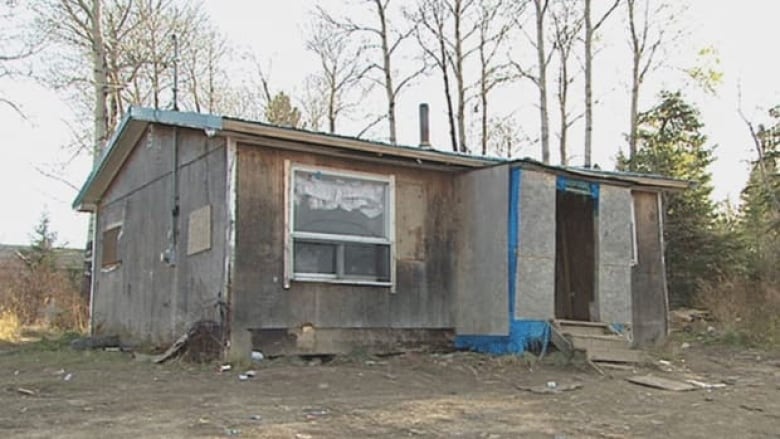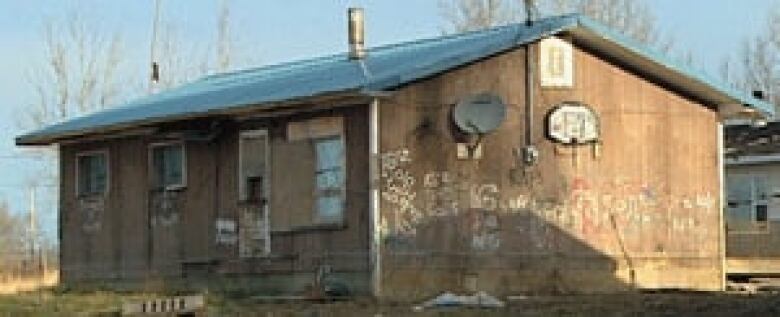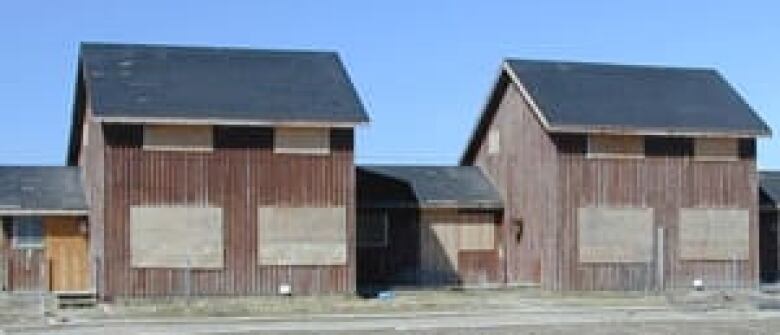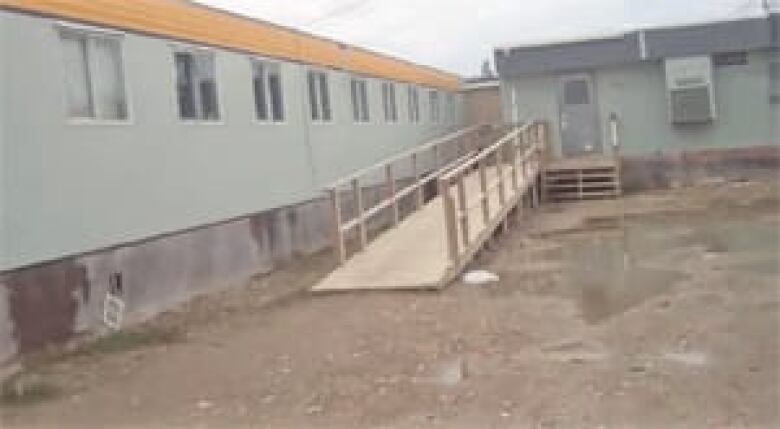First Nations housing in dire need of overhaul
Shortages, overcrowding and ramshackle homes the norm on many reserves

Thecurrent crisisin the northern Ontario Cree community of Attawapiskat may have brought the issue of First Nations housing into the headlines, but many reserves have been struggling with housing shortages and substandard living conditions for years.
Arecentfederal evaluation of First Nations housingconcluded that the housing shortage on reserves is severe and only getting worse.
According to the February 2011 report, 20,000 to 35,000 new units would need to be built to meet current demand (the Assembly of First Nations puts the figure closer to 85,000).
First Nations infrastructure
The CBC News seriesThe Big Fixexamines Canada's crumbling infrastructure and what's needed to repair it. Storiesthat look atinfrastructure challenges facing First Nations include:
Infrastructure overview:Shacks and slop pails: the infrastructure crisis on native reserves.Read the article
Water: bringing water and sewer systems on reservesup to standard and maintaining them that way for the next 10 years would cost about $10 billion.Read the article
Pikangikum: WatchColeen Rajotte's reportonthetroubled Ojibwa communityand visit the8th Fire Facebook siteto get a preview of 8th Fire, an upcomingCBC-Radio-Canada documentary series on aboriginal peoples in Canada.
Housing on reserves falls short by almost any measure and especially when compared with housing off reserve: 41.5 per cent of homes on reserves need major repairs, compared with seven per cent in non-aboriginal households outside reserves.
Rates of overcrowding are six times greater on reserve than off. In many communities, it's not uncommon to have three generations living under one roof not by choice but by necessity.
"There are people who are living like sardines in some units," says Jonathan Solomon, chief ofKashechewan First Nation, a fly-in Cree communityupstream fromJames Bay in northern Ontario. "Sometimes, there's 18 to 21 people living in small units, and it creates an unfit home environment."
Solomon, whose community wasevacuated in 2005because of a water crisis,worries about the effects this overcrowding has not just on the house itself but also on the mental and physical health of the people who live there, especially children, who, he says, generally do poorer in school under such conditions.
First Nations decide how funds used: government
When asked about overcrowding on reserves, Aboriginal Affairs and Northern Development Canada (AANDC), the federal department responsible for First Nations, said in a written response:

"First Nations are responsible for allocating their own housing funds, including decisions on the number of new units they may decide to build, according to the priorities and needs of the community."
But Solomon says there is no way he can meet the needs of his 1,900 residents at current funding levels. He said Kashechewan built 20 new housing units two years ago but needs 300 more, and the backlog keeps growing, as about 40 new babies are born every year.
The federal assessment found housing on reserves deteriorates much faster than off reserve, largely as a result of overcrowding but also because of poor construction and housing designs that often don't account for the environmental realities on reserve.
'A lot of contractors that came here thought that because it was on reserve, they didn't need to worry about quality as much.' Tsawwasen First Nation Chief Kim Baird
"A lot of contractors that came here thought that because it was on reserve, they didn't need to worry about quality as much," said Kim Baird, chief of theTsawwassen First Nation25 km south of Vancouver.
Maintenance is also a huge factor. The housing report found that of the 80 homes inspected, nearly every one needed repairs and that those repairs would cost a total of $1.6 million. Perhaps that'swhy less than 30 per cent of the homes on reserve that need repairs are getting them.
"We don't have a Pro Hardware store," said Solomon. "The closest place we can order [materials from] is Moosonee," 120 km south."We still have to bring those in by air, and it's not cheap," he added.
Normal bank mortgages not an option

Low income is another factor preventing people from being able to make the investments their homes need. Median annualincome on reserves is $11,300, according to the 2006 census (average income is $16,160). That also means the number of people who can buy new homes is fairly small.
"With isolated communities where there's no industry, it's hard for people to be able to afford market housing," said Solomon.
Homeowners on reserves can't own the land their house is on, which is held in trust by the Crown, which means they can't get normal bank mortgages because the property can't be seized.Instead, they must have their mortgages guaranteed by the Minister of Aboriginal Affairs and Northern Development, a process that can take up to a year.
"That's the unfortunate thing with the Indian Act: they're actually treated as children of the state," says Charlie Angus, NDP MP for Timmins-James Bay, whose riding includes Kashechewan and Attawapiskat.
[IMAGEGALLERY galleryid=1541 size=small]
The federal government did create aFirst Nations Market Housing Fundfour years ago to try to improve access to housing loans, but those loans must be guaranteed by the First Nation. It's a problem for cash-strapped communities to act as insurers if they're carrying their own debts.
That means it's up to band administrators to try to stretch the money they get from the federal government to cover repairs and thebuilding of new housing. In reality, they can rarely afford to do both.
On top of that, band councils manage non-profit rental housing, which is financed by the Canada Mortgage and Housing Corporation.

"If you're a First Nation trying to manage this mess, and you're collecting rent, and if there are arrears, then the problems get compounded," said Baird. "The maintenance and that start to slip, because there isn't cash in the bank to actually deal with those things, and you don't have a motivated group of tenants, because they're living in sub-quality housing."
Even though the government spends an average of $272 million a year on First Nations housing and since 2009 spent an additional $400 million through the economic stimulus plan, it's not enough to "get ahead of the curve of need," the housing evaluation concluded.
Attawapiskat crisis

The residents who lost their homes were housed in what were meant to be only temporary trailers donated by the De Beers mining company, which operates a diamond mine 90 kilometres west of Attawapiskat.
About 90 people are still living in those trailers, which De Beers uses to house its own employees and which cost the community $100,000 a year to maintain.
AUDIO: Life on reserve
Listen to CBC Radio's Karen Pauls report on life ontwo Manitoba reserves:
Gary and Darlene McDougall and their five children share a cramped, cold home with no indoor plumbing in Wasagamack First Nation.LISTEN
Three generations of the Harper family live in a home on the Wasagamack reservewith no running waterand a slop pailfor a toilet.LISTEN
"After some people left to go back to their units, more people moved in there, because they had no place to stay or they were living in overcrowded housing." said Attawapiskat Chief Theresa Spence.
Several dozen other people are living in five wood-frame tents and a few uninsulated sheds that the community put up to try to deal with its housing shortage.
With winter approaching, Attawapiskat declared astate of emergencyat the end of September. Aftera visit to the community in November from Angus, whoraised the issue in Parliamentand made a YouTube video to publicize it, the federal government agreed to spend $500,000 to renovate five vacant houses that had been condemned and which Angus says are in such a bad state they're not worth saving.
The Canadian Red Cross also intervened, sending staff, blankets and emergency suppliesto Attawapiskat to address some of the most immediateneeds.

Spence is glad for the help but says emergency aid anda fewrenovations won't resolve the community'slong-term housing shortage.
"Even if these people move out of the tent frames, the other families are going to move in there, because that's how much people require housing," said Spence.
'This is a community that has tried to do things right.' Charlie Angus, NDP MP for Timmins-James Bay
Attawapiskat has 1,800 residents and about 300 houses, with 314 people on a waiting list for housing. It has beenwaiting for a new elementary schoolsince 2000, when the old school was shut because of soil contamination and replaced with portables.
"This is a community that has tried to do things right," said Angus. "They've worked hard on action plans; they've got housing studies; they've got water studies ... but their water is so bad that it actually corrodes their pipes; they've got no school for 500+ kids; and now, we've got families living in tents."

AANDC said Attawapiskat received $450,000 for housing through the economic stimulus plan in 2009-11 in addition to its annual housing allocation, which for 2011-12 is $581,407.
But Spence says it can cost as much as $250,000 to build a house in the community, which is 500 kilometres north of Timmins, Ont., a few kilometers inland from James Bay, and relies on a winter ice road or expensive cargo flights to bring in materials and contractors. To meet all of its housing needs would take $84 million and federal approval to transfer new land to the reserveso a newsubdivision could be built.
Spence said the community's annual allocation of federal funding hasn't budged in years.
"The way we're getting funding is so limited," Spence said. "Each year, when the government calculates the funding, they calculate by population; they don't really look at the high cost of living."
- Shacks and slop pails: Infrastructure crisis on native reserves
- Clean water still a luxury on many reserves
The community gets some revenue from itsimpact benefit agreementwith De Beers, but that money goes straight to a trust fund that the community has put restrictions on so it can't be used for immediate housing needs. What's more, it pales in comparison to the benefits DeBeers and the Ontario and federal governments are getting from the mine, Angus said.
"This is a community that is living off land that is being exploited for massive wealth for Ontario's benefit, for the federal government's benefit, and they're being treated like animals," he said.
Between July 2008, when the mine opened, andJanuary 2011, Attawapiskatreceived$10.5 million in benefit payments, and De Beers made$488.88 million in gross revenue, although the company points out that the mine cost $1 billion to build and that the construction and operation of the mine has alsogenerated jobs and$325 million in business contracts for the community.












_(720p).jpg)


 OFFICIAL HD MUSIC VIDEO.jpg)
.jpg)



























































































